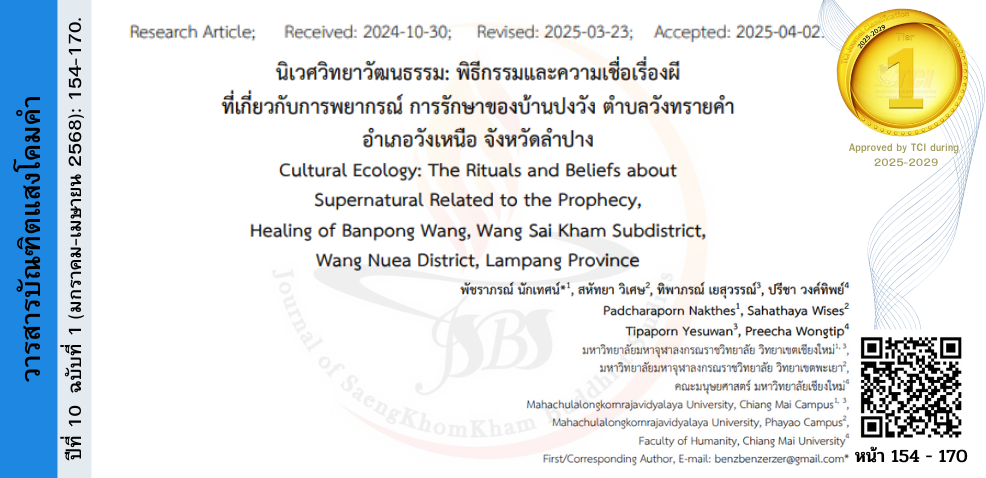นิเวศวิทยาวัฒนธรรม: พิธีกรรมและความเชื่อเรื่องผี ที่เกี่ยวกับการพยากรณ์ การรักษาของบ้านปงวัง ตำบลวังทรายคำ อำเภอวังเหนือ จังหวัดลำปาง
คำสำคัญ:
นิเวศวิทยาวัฒนธรรม, พิธีกรรม, ความเชื่อเรื่องผี, การพยากรณ์, การรักษาบทคัดย่อ
งานวิจัยนี้มีวัตถุประสงค์เพื่อ 1) ศึกษานิเวศวิทยาวัฒนธรรมที่เกี่ยวกับพิธีกรรมและความเชื่อเรื่องผีของบ้านปงวัง 2) ศึกษาการเปลี่ยนแปลงของพิธีกรรมและความเชื่อเรื่องผีที่เกี่ยวกับการพยากรณ์ การรักษาของชุมชน 3) วิเคราะห์รูปแบบการปรับตัวในการประกอบพิธีกรรมและความเชื่อเรื่องผีที่เกี่ยวกับการพยากรณ์ การรักษา ภายใต้การเปลี่ยนแปลงของชุมชน เป็นงานวิจัยเชิงคุณภาพ เก็บรวบรวมข้อมูลด้วยการศึกษาเอกสาร สำรวจพื้นที่ การสัมภาษณ์ผู้ให้ข้อมูลสำคัญ ได้แก่ พระสงฆ์ ผู้นำชุมชน ร่างทรง ผู้ประกอบพิธีกรรม ปราชญ์ชาวบ้าน ชาวบ้านที่อาศัยอยู่ในชุมชน และเจ้าหน้าที่โรงพยาบาลส่งเสริมสุขภาพตำบลบ้านปงวัง จำนวน 22 คน วิเคราะห์ข้อมูลด้วยการวิเคราะห์เนื้อหา
ผลการวิจัยพบว่า 1) ชุมชนบ้านปงวังมีความสัมพันธ์ใกล้ชิดกับระบบนิเวศป่าชุมชนและแม่น้ำ โดยรักษาพิธีกรรมดั้งเดิม ซึ่งสะท้อนถึงความเชื่อที่ผูกพันกับธรรมชาติและสิ่งเหนือธรรมชาติ พิธีกรรมเหล่านี้ไม่เพียงเสริมสร้างความเคารพต่อธรรมชาติและการอนุรักษ์ทรัพยากร แต่ยังส่งเสริมความสามัคคีในชุมชน นอกจากนี้ พบว่า การแพทย์สมัยใหม่จะเข้ามามีบทบาท ความเชื่อเรื่องผียังคงหลอมรวมเป็นส่วนหนึ่งของการรักษาสมดุลระหว่างมนุษย์และธรรมชาติ 2) พิธีกรรมและความเชื่อเรื่องผีในชุมชนบ้านปงวังได้ปรับเปลี่ยนเนื้อหาและขั้นตอนเพื่อให้สอดคล้องกับสังคมและเทคโนโลยีที่เปลี่ยนแปลงอย่างรวดเร็ว โดยมีปัจจัยหลักจากการเปลี่ยนแปลงทางภูมิวัฒนธรรม เศรษฐกิจและสังคม การผสมผสานระหว่างการแพทย์พื้นบ้านกับการแพทย์แผนปัจจุบันยังคงมีอยู่เพื่อให้การรักษามีประสิทธิภาพและสอดคล้องกับความเชื่อและวัฒนธรรมของชุมชน 3) รูปแบบการปรับตัวในการประกอบพิธีกรรมและความเชื่อเรื่องผีที่เกี่ยวกับการพยากรณ์ การรักษา ภายใต้การเปลี่ยนแปลงของชุมชนมี 3 รูปแบบ คือ (1) การปรับตัวด้านร่างกาย (2) การปรับตัวด้านวิธีคิด (3) การปรับตัวด้านความสัมพันธ์ในสังคม องค์ความรู้จากการวิจัย คือ วัฒนธรรมมีบทบาทในการกำหนดการจัดการทรัพยากรธรรมชาติ ช่วยส่งเสริมความเป็นเอกลักษณ์ของชุมชน ความสามัคคีและการจัดการสิ่งแวดล้อมอย่างรับผิดชอบ
Downloads
เอกสารอ้างอิง
กิตติภพ พูลสุข. (2562). การผสมผสานภูมิปัญญาพื้นบ้านกับการแพทย์แผนปัจจุบันในชุมชนชนบท. กรุงเทพมหานคร: มหาวิทยาลัยธรรมศาสตร์.
โกมาตร จึงเสถียรทรัพย์ และประชาธิป กะทา. (2550). สุขภาพปฐมภูมิ บริการปฐมภูมิ จากปรัชญาสู่ปฏิบัติสุขภาพมิติใหม่. นนทบุรี: สำนักวิจัยสังคมและสุขภาพ (สวสส.).
จิตราภรณ์ นิลสุวรรณ. (2561). ความยืดหยุ่นของพิธีกรรมท้องถิ่นในบริบทสังคมปัจจุบัน. กรุงเทพมหานคร: จุฬาลงกรณ์มหาวิทยาลัย.
จิตสุภา แก้วคำ. (2564). บทบาทของพิธีกรรมในชุมชนต่อการรักษาความสัมพันธ์และสุขภาพจิตในยุคปัจจุบัน. เชียงใหม่: มหาวิทยาลัยเชียงใหม่.
ณฤณีย์ ศรีสุข. (2564). นิเวศวิทยาวัฒนธรรมเชิงพุทธบูรณาการ. วารสารวิทยาลัยสงฆ์นครลำปาง. 10 (1), 187-202.
ธนู แก้วโอภาส. (2549). ศาสนาโลก, พิมพ์ครั้งที่ 3. กรุงเทพมหานคร: สุขภาพใจ.
ธเนศวร์ เจริญเมือง. (2562). การเปลี่ยนแปลงในชนบทไทย: การปรับตัวและความอยู่รอด. กรุงเทพมหานคร: ศูนย์มานุษยวิทยาสิรินธร.
นฤมล ชูจันทร์. (2561). การอนุรักษ์และพัฒนาวัฒนธรรมในชนบทไทย: แนวทางสู่ความยั่งยืน. กรุงเทพมหานคร: จุฬาลงกรณ์มหาวิทยาลัย.
เบญจภัคค์ เจริญมหาวิทย์. (2563). ลำฝีฟ้า โลกทัศน์ความเชื่อด้านการรักษาสุขภาพของชาวอีสาน. วารสารวิชาการ คณะมนุษศาสตร์และสังคมศาสตร์ มหาวิทยาลัยราชภัฏนครสวรรค์. 7 (2), 76-87.
พัฒนา กิติอาษา. (2544). ทรงเจ้าเข้าผีในวัฒนธรรมสุขภาพไทย. รายงานการวิจัย. โครงการวิจัยความหลากหลายของวัฒนธรรมสุขภาพในสังคมไทย ศูนย์มานุษวิทยาสิรินธร (องค์การมหาชน).
พิเชฐ สายพันธ์. (2560). การจัดการทรัพยากรธรรมชาติอย่างยั่งยืนในมิติของชุมชน. กรุงเทพมหานคร: มหาวิทยาลัยธรรมศาสตร์.
มาลา คำจันทร์. (2544). เล่าเรื่องผีล้านนา. กรุงเทพมหานคร: มติชน.
วรรณา ทองสุข. (2563). การปรับตัวของความเชื่อและพิธีกรรมในยุคสมัยใหม่: การศึกษาเปรียบเทียบในพื้นที่ชนบทและเมือง. เชียงใหม่: มหาวิทยาลัยเชียงใหม่.
ศรีศักร วัลลิโภดม. (31 มีนาคม 2566). ปริทัศน์ความเชื่อเรื่องผีในประเทศไทย. งานเสวนาวิชาการ หัวข้อ "ปริทัศน์ความเชื่อเรื่องผีในประเทศไทย” กรมศิลปากร. สืบค้นเมื่อ 12 กรกฎาคม 2566, จาก https://www.silpa-mag.com/culture/article_105176
สมชาย ปานใจ. (2562). บทบาทของชุมชนในการอนุรักษ์ทรัพยากรธรรมชาติ: กรณีศึกษาป่าชุมชน. เชียงใหม่: มหาวิทยาลัยเชียงใหม่.
สามารถ ใจเตี้ย และวรางคณา สินธุยา. (2562). ผีล้านนาในมิติการสร้างเสริมสุขภาพชุมชน. วารสารวิจัยราชภัฏพระนคร สาขาวิทยาศาสตร์และเทคโนโลยี. 14 (2), 161-169.
สามารถ ใจเตี้ย. (2561). การสื่อสารพิธีกรรมล้านนาเพื่อการสร้างเสริมสุขภาพ. วารสารวิชาการนวัตกรรมสื่อสารสังคม. 6 (2), 142-151.
สุวิภา จำปาวัลย์ และคณะ. (2560). พิธีกรรมเพื่อแก้ปัญหาสุขภาพจิตของกลุ่มชาติพันธุ์ไทลื้อ ไทยวน ไทใหญ่: การดำรงอยู่และการเปลี่ยนแปลงภายใต้อิทธิพลของสังคมโลกาภิวัตน์. รายงานการวิจัย. สถาบันวิจัยสังคม มหาวิทยาลัยเชียงใหม่.
อนุกูล ตันสุพล. (2559). นิเวศวิทยาวัฒนธรรม: กุญแจสู่การพัฒนาที่ยั่งยืน. วารสารวิชาการ คณะมนุษยศาสตร์และสังคมศาสตร์. 12 (1), 193-221.
อภินันท์ สุวรรณรักษ์. (2563). ผลกระทบของเศรษฐกิจชนบทต่อวิถีชีวิตและวัฒนธรรม. เชียงใหม่: มหาวิทยาลัยเชียงใหม่.
Steward, J. H. (1955). Theory of Culture Change: The Methodology of Multilinear Evolution. Urbana, IL: University of Illinois Press.

ดาวน์โหลด
เผยแพร่แล้ว
รูปแบบการอ้างอิง
ฉบับ
ประเภทบทความ
สัญญาอนุญาต
ลิขสิทธิ์ (c) 2025 วารสารบัณฑิตแสงโคมคำ

อนุญาตภายใต้เงื่อนไข Creative Commons Attribution-NonCommercial-NoDerivatives 4.0 International License.





